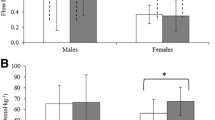Summary
Saliva immunoglobulin A (IgA) and cortisol levels were measured in 21 male members of a major midwestern swim team. Saliva samples were collected before and after training sessions four times during the fall season; the training intensity was light, moderate, heavy and during the taper period before a major competitive meet. Saliva IgA levels were decreased after each training session, reaching statistical significance with the moderate training intensity. Over the 3-month training period the pre-session and post-session IgA levels both decreased significantly during the heavy and taper training intensities later in the fall season. Cortisol levels were significantly elevated only after the heavy-intensity training session. The Profile of Mood States (POMS) was used to assess the swimmers' overall mood on each test day. No significant correlations were found between the global POMS score and IgA or cortisol. Also, cortisol and IgA were not significantly correlated except after the light training session. Results from this study indicate that acute bouts of exercise can reduce salivary IgA levels and that chronic exercise of high intensity can reduce the resting levels of IgA. These changes may render the athletes more vulnerable to respiratory infections after exercise and even at rest during the later stages of the competitive season.
Similar content being viewed by others
References
Bratthall D, Widerstrom L (1985) Ups and downs for salivary IgA. Scand J Dent Res 93:128–134
Cannon J, Kluger M (1984) Exercise enhances survival rate in mice infected withSalmonella typhimurium. Proc Soc Exp Biol Med 175:518–521
Douglas DJ, Hanson PG (1978) Upper respiratory infections in the conditioned athlete. Med Sci Sports 10:55
Dufaux B, Order U, Geyer H, Hollmann W (1984) C-reactive protein serum concentrations in well-trained athletes. Int J Sports Med 5:102–106
Duncan JJ, Vaandrager K, Kohl HW (1988) Immunologic response to endurance training in hypertensive subjects receiving beta blocker therapy. Med Sci Sports Exerc 20:S19
Engvall E (1980) Enzyme immunoassay ELISA and EMIT. Methods Enzymol 70:419–438
Fernandes G, Jeng G, Baker D (1985) Effect of exercise during middle age on immune function in mice maintained on a normal and/or restricted calorie intake. Fed Proc 44:767
Fernandes G, Rozek M, Troyer D (1986) Reduction of blood pressure and restoration of T-cell immune function in spontaneously hypertensive rats by food restriction and/or by treadmill exercise. J Hypertens 4:S469-S474
Good R, Fernandes G (1981) Enhancement of immunologic function and resistance to tumor growth in balb/c mice by exercise. Fed Proc 40:1040
Houston H, Hoffman-Goetz L, Houston M, Keir R (1987) Immunological responses to exercise training in man. Fed Proc 46:680
Mackinnon L, Chick T, As A van, Tomasi T (1986) Decreased levels of secretory immunoglobulins following prolonged exercise. Med Sci Sports Exerc 18:S40
McNair D, Lorr M, Doppleman L (1971) Profile of mood states manual. Educational and Industrial Testing Service, San Diego
Morgan W (1985) Selected psychological factors limiting performance: a mental health model. In: Eckert H, Clarke H (eds) The limits of human performance. Human Kinetics, Champaign, pp 70–80
Pahlavani M, Cheung T, Chesky A, Richardson A (1988) Influence of exercise on the immune function of rats of various ages. J Appl Physiol 64:1997–2001
Riley V (1981) Psychoneuroendocrine influences on immunocompetence and neoplasia. Science 212:1100–1109
Stein M, Keller S, Schleifer J (1985) Stress and immunomodulation: the role of depression and neuroendocrine function. J Immunol 135:827s-833s
Tecoma E, Huey L (1985) Psychic distress and the immune response. Life Sci 36:1799–1812
Tharp G (1975) The role of glucocorticoids in exercise. Med Sci Sports 7:6–11
Tomasi T, Trudeau F, Czerinski D, Erredge S (1982) Immune parameters in athletes before and after strenuous exercise. J Clin Immunol 2:173–178
Watson R, Moriguchi S, Jackson J, Werner L, Wilmore J, Freund B (1986) Modification of cellular immune functions in humans by endurance exercise training during beta-adrenergic blockade with atenolol or propranolol. Med Sci Sports Exerc 18:95–100
Author information
Authors and Affiliations
Rights and permissions
About this article
Cite this article
Tharp, G.D., Barnes, M.W. Reduction of saliva immunoglobulin levels by swim training. Europ. J. Appl. Physiol. 60, 61–64 (1990). https://doi.org/10.1007/BF00572187
Accepted:
Issue Date:
DOI: https://doi.org/10.1007/BF00572187




